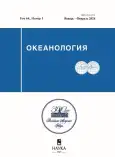Современные методы и технические средства экологического мониторинга устьев малых рек
- Авторы: Антоненков Д.А.1
-
Учреждения:
- Морской гидрофизический институт РАН
- Выпуск: Том 64, № 1 (2024)
- Страницы: 153-164
- Раздел: Приборы и методы
- URL: https://journals.eco-vector.com/0030-1574/article/view/657692
- DOI: https://doi.org/10.31857/S0030157424010116
- EDN: https://elibrary.ru/SNLPJC
- ID: 657692
Цитировать
Полный текст
Аннотация
В настоящее время устья рек интенсивно осваиваются, в связи с чем требуется получение актуальной информации об их современном экологическом состоянии, гидрологическом режиме и географических особенностях. В соответствии с этим важным является разработка и усовершенствование методов и технических средств экологического мониторинга устьев рек. В статье приведена разработанная методика комплексных исследований устьев малых рек, основанная на применения новых технических средств и методов. Показан опыт применения современных приборов отечественной разработки для решения практических задач комплексного водно-экологического мониторинга на примере выполнения экспедиционных работ в устье р. Черная, Севастопольской бухте (п-ов Крым, г. Севастополь). Описаны возможности используемых технических средств: CTD-зонда ГАП-АК-12Р (МГИ РАН), биофизического комплекса «Кондор» (НПП «Аквастандарт»), эхолота Garmin, позволяющих получать натурные данные о мутности, концентрации взвеси, скорости и направлении течения, среднем размере взвешенных частиц, солености и температуре водной среды. Представлены результаты применения нового метода определения скорости течения и расхода воды, основанного на обработке видеоизображений. Применение разработанной методики дает возможность получить информацию, необходимую для анализа гидрологического режима и экологического состояния устьев малых рек.
Ключевые слова
Полный текст
Об авторах
Д. А. Антоненков
Морской гидрофизический институт РАН
Автор, ответственный за переписку.
Email: dmitry_science@mail.ru
Россия, Севастополь
Список литературы
- Алабян А.М., Беликов В.В., Крьшенко И.Н., Лебедева С.В. Применение двумерных гидродинамических моделей для решения проблем регулирования русла Нижней Волги в условиях дефицита данных гидрологических изысканий // Инженерные изыскания. 2014. № 2. С. 18–28.
- Антоненков Д.А. Измерительный комплекс для исследования динамических характеристик и структуры течения водного потока в прибрежной морской зоне // Изв. вузов. Приборостроение. 2020. Т. 63. № 12. С. 1112–1118. https://doi.org/10.17586/0021-3454-2020-63-12-1112-1118
- Архипкин В.С., Лазарюк А.Ю., Левашов Д.Е., Рамазин А.Н. Океанология // Инструментальные методы измерения основных параметров морской воды: Учебное пособие. М.: Изд-во МАКС Пресс, 2009. 335 с.
- Гидрозонд автономный портативный «ГАП-АК-12Р». URL: http://mhi-ras.ru/sensors/gidrozond_avtonomnyj_portativnyj_GAP-AK-12R.html. (дата обращения 28.09.2022).
- Клавен А.Б., Копалиани З.Д. Экспериментальные исследования и гидравлическое моделирование речных потоков и русловые процессы. СПб: Нестор–История, 2011. 504 с.
- Комплекс гидробиофизический мультипараметрический погружной автономный «КОНДОР». URL: http://ecodevice.com.ru/ecodevice-catalogue/multiturbidimeter-kondor (дата обращения: 30.04.2023г.).
- Лучшева А.А. Практическая гидрометрия. Л.: Гидрометеоиздат, 1983. 424 с.
- Методические указания. Гидрологические наблюдения и работы на гидрометеорологической сети в устьевых областях рек: Руководящий документ РД 52.10.324-92. Введ. с 01.01.1993 г. по 2002 год. М., 1993. 188 с.
- Миньковская Р.Я. Комплексные исследования разнотипных морских устьев рек (на примере морских устьев рек северо-западной части Черного моря): электронный ресурс / Р.Я. Миньковская; ФГБУН ФИЦ «Морской гидрофизический институт РАН». Севастополь, 2020. 364 с. ISBN 978-5-6043409-2-9. https://doi.org/10.22449/978-5-6043409-2-9
- Михалев В.Н., Добровольский А.Д., Добролюбов С.А. Гидрология: учебник для вузов. Изд. 3-е, стер. М.: Высш. шк., 2008. 463 с.
- Наставление гидрометеорологическим станциям и постам. Выпуск 9. Гидрометеорологические наблюдения на морских станциях и постах. Часть 1. Гидрологические наблюдения на береговых станциях и постах: Руководящий документ РД 52.10.842-2017. Введ. с 27.11.2017 г. № 595 по 2022 год. М., 2017. 375 с.
- Руководство по гидрометеорологическому исследованию устьевых областей рек, впадающих в море: Руководящий документ РД 52.10.879-2019 утвержден 23.07.2019 / ФГБУ «Государственный океанографический институт имени Н. Н. Зубова»; Введ. с 08.11.2019 г. № 579 по 2025 год. М., 2020. 86 с.
- Хмелевой С.В. Использование GPU для расчетов скоростей газо-жидкостных сред с помощью метода PIV // Радиоэлектронные и компьютерные системы. 2012. № 6 (58). С. 124–129.
- Antonenkov D.A. Water flow speed determining using visualization methods // Scientific Visualization. 2020. V. 12. № 5. P. 102–111. https://doi.org/10.26583/sv.12.5.09
- Chepyzhenko A.A., Chepyzhenko A.I. Methods and device for in situ total suspended matter (TSM) monitoring in natural waters’ environment // Proc. SPIE 10466, 23rd International Symposium on Atmospheric and Ocean Optics: Atmospheric Physics, 104663G (30 November 2017). https://doi.org/10.1117/12.2287127
- Dykman V.Z. Technical tools for studying structure and dynamics of water masses // Physical Oceanography. 2016. № 6 (192). P. 43–55.
- Jahanmiri M. Particle Image Velocimetry: Fundamentals and Its Applications. Research report 2011:03. Department of applied mechanics, Chalmers University of technology, Göteborg, Sweden. 2011. 58 p.
Дополнительные файлы




















